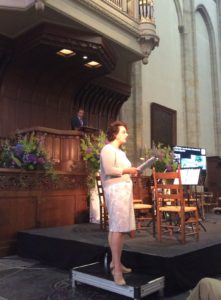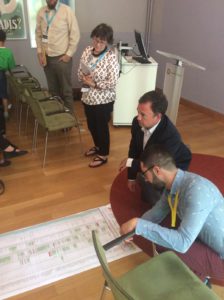
Because of the abundance of ceremonies and niceties on the first day (see introductory post here) the attendees were to sit through only one block of parallel sessions. That does not prevent me from making this first day journal a long one.
I attended the practitioners’ lab on communal land ownership, titled “What can customary landowners around the world learn from commons in modern Europe?” The lab consisted of, first, a kickoff by representatives of LandMark, a voluntary initiative pursuing a worldwide map of communal and indigenous land, followed by short presentations of researchers from different European regions. LandMark is a courageous effort that could be seen as crowdsourced or bottom-up, but actually adheres strongly to expert and formal knowledge in something you could call two-step verification. Only when the people say that certain land is ‘theirs’, consent on disclosure, and either public authorities or experts corroborate the entitlement, a claim is added to the map. That has resulted so far in 1.15 million recorded communal lands, on top of which are stacked layers with supplementary information on how countries deal with this kind of tenure.
The European context
The lab revealed some interesting insights. For example on the difference between issues of communal land ownership in the global South and Europe. In many parts in the South, the main issues are the vulnerable position of communities whose land claims are not recognized, and secondly, conflicting land claims that are mainly attributable to the disturbance of historical arrangements since colonial times. In Europe, however, the history of modernization – state formation, the influence of markets – was longer and somewhat more gradual. As a consequence, communal land ownership and management seem a thing of times way past, and LandMark shows nothing but blanks in the European Union. But in practice, many communities do exert influence on, or lead (staying within the confines set by legislation), land management throughout Europe. In Europe, communal land claims are not so much denied or conflictual, but assimilated in the net of modern public-private arrangements.
Let’s skim through some examples, starting off with Romania. Here one can discern three types of common lands, stemming from different historical influences and turbulences. To cut it short: there are small commons, large ones, and large monetized ones. Monetized means here that most folks have their entitlements because of heredity but live elsewhere, often in cities where the work is. They receive the occasional dividend from land concessions to private firms on their commons. As the ‘commoners’ lack a real tie to the land, we’re talking about communal land management of sorts.
In Germany, forested land from communal origin are still quite abundant, but governance structures have been mostly assimilated in public (federal and state) and private spheres. We see clearly the traces of communal ownership in arrangements that are sometimes under public control, but more often private models have replaced, while allowing for some retention of communal control, the former common lands.
In Switzerland, roughly 80% turned into public land and 20% private land while in Austria this proportion is reversed. But despite this remarkable difference, remainders of common property institutions are widespread in both countries. Switzerland for example has a rich history of cooperatives (Genossenschaften) and commons mainly in the Alps – including of course the famous recorded case of Törbel by Robert Netting.
I want to remark here that ‘private’ and ‘public’ are usually seen as antagonistic realms, but actually, private property is virtually fully dependent on public authorities and institutions. This blog is already too long, so I refrain from clarifying this point at this moment. If you think my remark was not quite obvious, you must forgive me the insertion of a teaser.
Distant commoning?

One of the contributors to the panel was Asociación Forestal de Soria, the 2017 winner of the Elinor Ostrom Award for Practitioners. Asociación Forestal de Soria is an association that provides representation and defence to the owners of forests in private regime of the province of Soria, Spain. Today it represents more than 10,000 people holding some 80,000 hectares of forest land. These people, however, live at a distance. Pedro Gil, the association’s president, mentioned a village composed of only eight people, each of them quite old too. But because of the work of Soria, there are 480 ‘new commoners’ associated to this village. The association’s (award winning) purpose is to involve people from the cities in sustaining rural areas and to rehabilitate communal governance. This sparked quite some debate: some considered ‘distant commoning’ an oxymoron. Commoning requires real participation, observation, contextual knowledge; citizens holding entitlements or shares at a distance may not be able to make the right decisions for the common. Examples of this were provided by the reports from the ‘monetized commons’ in Romania, where the entitled receive standardized benefits, i.e. money, instead of directly sensing the costs and benefits of management decisions. But the Soria group is well aware of this point and has went beyond mere monetization. The crucial point is to ‘reconstruct’ the community through revealing familial/ancestral relations: much of the work of Soria consists of mapping, even of reverse engineering, the history of the common and the people that have taken responsibility over the course of years. That way, Soria creates connection not only between current (dispersed) communities but also between the generations.
European rural land: commoning challenges
A concluding point relates to the specific sustainability context of European land use. As Evelyn Dietsche succinctly put it, “living off the land is not sustainable anymore” in Europe – in the sense of economically feasible. And that holds not only for the extinct subsistence lifestyle, but to reasonable-scale agriculture in general. The simple reason is that food prices are too low to earn a living if you’re not willing or able to engage in agro-industrial production – or run your business on debt. As a consequence, consumers of food and forest products – i.e. the community – and the sites of agricultural production, have drifted apart further and further, with due implications for the sustainability of the land. That is why the panel convener saw a “strong case for restitution of the commons” – and in such a (novel) way that overlapping interests in different ‘layers’ (wind, soil, water), all with different geographies, are turned from areas of conflict into areas of cooperation.
(Navigate to earlier/later posts using the arrow links, underneath the ‘Posted in…’ line below.)
